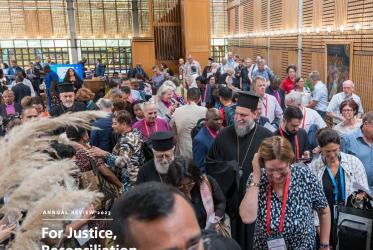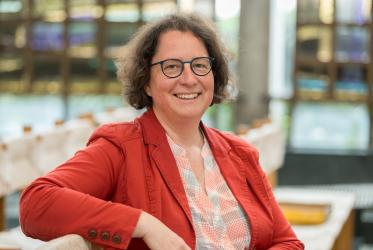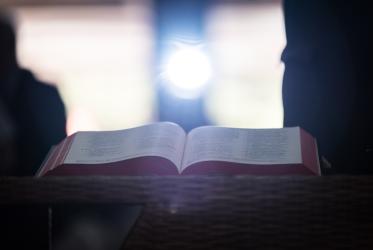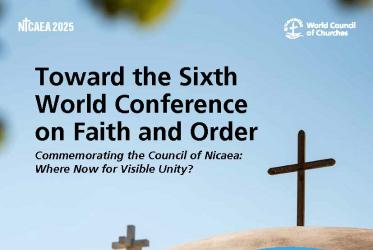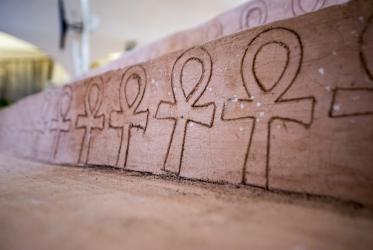By Odair Pedroso Mateus *
As you access the facsimile of the text, available for free downloading at the Faith and Order digital library, you learn that the paper was published in 1913; that its series number is 15; and that its title is “Prayer and Unity.” But all it says about its author is what is printed after the title: “by a layman.” Who was the layman?
I suppose that the mysterious “layman” was Robert Gardiner (1855-1924 and not 1882-1944 as in An Episcopal Dictionary of the Church), an American Episcopal lawyer, who was from 1910 until his death the driving force behind Charles Brent’s vision of a global ecumenical movement focused on addressing and overcoming controversial matters of faith and church order.
However, this is just intuition. It is true that in those early days, the very clerical movement on Faith and Order was also supported by “laymen,” one of them being a certain J. P. Morgan. But when I think of Gardiner’s piety, his tireless dedication to what was at stake in Faith and Order, and the choice of bibliographic references presented at the end of the paper, I say to myself that the Faith and Order servant who never sat in the shade of the tree he helped to plant and water for 14 years may well have penned this anonymous Prayer and unity.
Gardiner or not, the anonymous layman welcomes in 1913 “the increasing desire… for that unity which shall bring the world to Christ:” division, he notes, has been a source of “waste and inefficiency” to home and overseas mission.
However, we must recognise, he contends, that despite this encouraging sign, “we have not yet reached the essence of the problem” of division, nor have we brought ourselves “to the only means of solving it.”
The essence of the problem of remaining divisions is the churches’ lack of penitence and the means to solve it is… prayer. If we are to advance towards unity, “we must search our consciences for our faults of pride and self-sufficiency, and then in all humility seek to comprehend what unity is.” When that surrender to God is made, “each is one with God and therefore one with all others who are one with Him. So, it may be said that prayer is unity and unity is prayer.” Unity is to be sought “in the absolute submission of our wills to God’s.”
The anonymous layman’s case for penitence and prayer as the way to unity would remain virtually confidential until the day when, almost 50 years later, in 1962, a relatively young theologian, freshly appointed to the Secretariat of the WCC Faith and Order Commission, invoked its authority in a short article called “Praying Together for Unity,” in order to answer to the following, timely and more complex question: can churches which disagree on what they mean by visible unity pray together for it while remaining true to themselves and to each other?
Born in Protestant Basel, the Swiss Lukas Vischer, a Karl Barth’s doctoral student, was 34 when he joined Faith and Order in 1961 as its research secretary. He would be its outstanding director from 1965 to 1979, joining afterwards the faculty of theology of the University of Bern and the Federation of Swiss Protestant Churches.
I suspect that Vischer would not have quoted the anonymous Layman just less than one year after joining Faith and Order, had he not applied first to himself the advice he gave to the future WCC general secretary, Konrad Raiser, in October 1969, when the young Raiser, then 31, joined the Faith and Order Secretariat: read as much as possible in the first six months to get to know the work of the commission; later it will be more difficult to find the time for concentrated study and research. Raiser did it.
Vischer’s “Praying Together for Unity” was published in that holy cow of 20th century ecumenical debate called The Ecumenical Review, in July 1962. What a time! In the previous year, the World Council of Churches had reached one of the peaks of its institutional prominence: In November, as the non-Roman Catholic world from all continents gathered in New Delhi, India, the WCC general secretary W.A. Visser ‘t Hooft was on the cover of Time Magazine with the headline “The Second Reformation.” Preparing its Vatican II Council, in which Vischer would play an important role as one of the WCC observers, the Church of Rome was placing the question of Christian unity high on its agenda. In such kairos, it was vital to make the case for strengthening spiritual ecumenism. Vischer did it.
For the anonymous Layman, the medicine for divisions that hinder mission was repentance and prayer for unity. For Vischer, prayer for unity is taken for granted. Today Christians of all traditions, he notes at the outset, pray for the unity of the Church of Christ. This is nothing new. “The Christian churches share an awareness that the state of division in which they find themselves is intolerably inconsistent with the will of Christ.”
What makes problems – indeed theological problems - is divided churches praying together for unity. Common prayer for unity, he contends, “is hedged about with considerable difficulties.” The first one is that “individual churches diverge from one another in their understanding of prayer.” As a result, “it cannot be taken for granted that a point can be reached where people pray together."
The second difficulty is “more profound.” The separated churches represent different conceptions of the true unity of the church. As a result, when Christians of different traditions ask for unity, “they are not therefore praying the same prayer from the outset, and indeed it may even be that their prayers are directed against each other.” Many have come to the conclusion “that common prayer for unity is fundamentally impossible.”
Vischer hasn’t. This difficulty, in his view, can be overcome. How? It is at this point that he evokes and invokes the witness and authority of the anonymous layman and his case for penitence and prayer.
This obstacle disappears, Vischer writes, “if we proceed consistently from the fact that in our prayer we are addressing God himself and asking him, through Jesus Christ, for his gift.”
Without giving up our convictions, Vischer writes, we are agreed “that all of us, each from his own standpoint, are reaching out to God with the plea that we may be sanctified according to the will of Christ.” If we are one in this parallel alignment, we are no longer turned against one another in our prayers.” This common movement is “the basis of common prayer.”
But is this a sound basis for prayer gathering together Roman Catholics and non-Roman Catholics?
Admittedly, the problem of common prayer, Vischer notes in 1962, presents itself “in a particularly acute form” in the encounter between the Roman Catholic Church and other traditions. The Church of Rome “sees itself as the one true church.” Thus, unity is realised “only when the primacy accorded by Christ to Peter and his successors is acknowledged.” It follows that when Catholics pray for unity, they are bound to pray for the return of the “separated brethren.” This makes impossible common prayer for unity as the “separated brethren” – be them Orthodox, Anglicans or Protestants - do not feel able nor acceptable to pray in this way.
Vischer believes that the approach to common prayer which he is proposing in continuity with the anonymous layman remains a sound basis for praying together with Roman Catholics despite conflicting understandings of what Christian unity implies. He goes on to contend that in many countries, Roman Catholics have “a different and more profound understanding of the petition for unity.”
Perhaps Vischer had in mind the Benedictine “monks of unity” of Chevetogne, Belgium, who, under the initial inspiration of Dom Lambert Beauduin, renewed the approach and methods of Roman Catholic ecumenical work. The first Roman Catholic vice-moderator of the WCC Commission on Faith and Order was, unsurprisingly, Dom Emmanuel Lanne, himself a “monk of unity” from Chevetogne.
But Vischer’s attention was in fact drawn to the spiritual ecumenism and the unusual ecumenical initiatives taken in Lyon, France, by the most well-known French Roman Catholic priest of the 1940s, Father Paul-Irénée Couturier (1881-1953).

Father Paul-Irénée Couturier.
Orthodox spirituality, time spent in Chevetogne, and the cosmic Christology of Teilhard de Chardin led Couturier, in a 1935 article finally published in 1937, to propose that the week of prayer for Christian unity launched by Paul Wattson in 1908 leave in God’s hands the ultimate form of the unity we seek so that non-Roman Catholics would be able to join Catholics in prayer for unity. He envisaged unity as a reunion of which all we know is that “God wills it because Christ prayed for unity.”
Couturier, who pioneered the creation of the Groupe des Dombes, a very respected community of prayer and ecumenical theological work, used to distinguish and hold together the unity of Christians (the overcoming of divisions that prevent full eucharistic fellowship among churches) and Christian unity (the biblical vision of the reconciliation of all things in Christ).
Vischer believes that as he prayed for unity “as Christ wills and by the means he wills,” Couturier had “clearly grasped the tension inherent in prayer for unity.” It is precisely with – and not without - this tension between the striving for unity and faithfulness to our different views on unity, Vischer contends, that we should “cast ourselves upon God.” He asks: “Can we not pray together that God may resolve the conflict which none of us is able to deal with on his own?” And he quotes the anonymous layman: “What is needed is that we should take the step of total surrender to and absolute trust in the infinite goodness and the infinite power of the risen Christ.”
According to Vischer, Father Couturier’s thinking “has advanced the conversation between the churches in considerable measure.” It has given a new direction to “the Octave of Prayer in January,” which can now be embraced by “large sections of the Christian world as a time of common prayer for unity.”
But how to respond to the main objection to Couturier’s approach to common prayer for unity, namely that it “represents in the final analysis a diminution or at least a suspension of the teaching of the [Roman Catholic] Church” on where unity lies and, consequently, how it is made visible?
This objection, Vischer contends, fails again “to take account of the fact that in prayer we stand before God.” God is the giver, “and we come before him in the dependent attitude of the humble suppliant.” We know and we don’t deny “what he has given us in Christ.” But when we pray, “we become aware primarily of how infinitely far removed we are from having seized hold of and understood God’s gift” of unity. Thus, Couturier’s approach to praying for unity “is neither a diminution nor a suspension of the teaching of the Church.”
Vischer hoped, on the eve of Vatican II, that the upcoming Roman Catholic Council would “give explicit and official recognition to the prayer for unity as Christ wills.” Four years after the publication of “Praying Together for Unity” and much conciliar deliberation in Rome, the WCC Commission on Faith and Order and the Roman Catholic Secretariat for Promoting Christian Unity began to work together in the production of resources for the week of (common) prayer for Christian unity, with the active participation of Unité Chrétienne, the Lyon based ecumenical centre which continues today, as the Groupe des Dombes, to embody the ecumenical spiritual vision of Father Couturier.
* Odair Pedroso Mateus was director of the WCC Commission on Faith and Order (2015-2022), WCC deputy general secretary (2020-2022) and professor of ecumenical theology at the WCC Ecumenical Institute at Bossey, Switzerland (2004-2021).
The author dedicates this text to his former colleagues of the WCC-Roman Catholic Church international group in charge of preparing resources for the week of prayer for Christian unity.
Resources
Faith and Order Papers Digital Edition
Week of Prayer for Christian Unity
Groupe des Dombes, For the Conversion of the Churches, WCC, 1993.
Anne-Noëlle Clément, L’Abbé Paul Couturier – Unité des chrétiens et unité de l’humanité, 2015.


